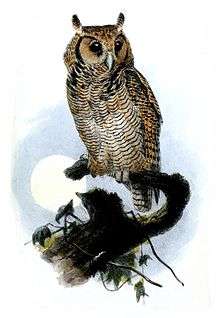Fraser's eagle-owl
Fraser's eagle-owl (Bubo poensis) is a species of African owl in the family Strigidae. It is named after the British zoologist Louis Fraser.[2]
| Fraser's eagle-owl | |
|---|---|
 | |
| Scientific classification | |
| Kingdom: | Animalia |
| Phylum: | Chordata |
| Class: | Aves |
| Order: | Strigiformes |
| Family: | Strigidae |
| Genus: | Bubo |
| Species: | B. poensis |
| Binomial name | |
| Bubo poensis Fraser, 1853 | |
| Synonyms | |
| |
Description
Fraser's eagle-owl is a relatively small species of eagle-owl with has rather "fluffy" ear tufts and a facial disc with a distinct dark rim. The upperparts are rufous and buffy brown, barred with darker bars, the pale scapulars have dark edged outer webs which show as a series of pale dots across the shoulder. The flight and tail feathers have narrow light and dark bars. The underparts are pale rufous shading to whitish on the belly and undertail coverts. Total length 39–42 cm (15–17 in), females larger than males.[3]
Voice
The territorial song of the male Fraser's eagle-owl is a rapid, stuttering and long deep, guttural trill which has been said to resemble the noise made by an electricity generator. There is also a two syllable hoot, which is stereotypically owl like, with the second syllable being higher pitched and more whistled. The double hoot is repeated at intervals of 3–4 seconds, and to the listener familiar with it, similar to the hoot of the European tawny owl. Another call, which is given by both sexes, used is a single soft mewing "wooh". They snap their bills to communicate, as do many owls.[3]
Distribution
It is widely spread across the African tropical rainforest[3] ; also found on Bioko.[4]
Habitat
Their habitat is primarily forest, forest clearings, and cardamom plantations. Ranges from sea-level up to about 1,600 m (5,200 ft), in Cameroon.[3]
Biology
Like most owls Fraser's eagle-owl is a nocturnal bird, roosting during the day hidden by leaves, about 40 m (130 ft) above the ground. The roost site is often located by small, diurnal birds which mob the owl. The birds stop roosting at dusk and become active, singing is most often in the early evening, just after dusk, but they will also sing just before dawn.[4] Its main prey is small mammals, such as mice, squirrels and galagos, and it also takes birds, frogs, reptiles, insects and other arthropods as well as the occasionally feeding on fruit.[3]
The breeding biology of Fraser's eagle-owl is little known. In Gabon they are reported as singing in June–September but breeding seems to take place throughout the year, apparently varying geographically with egg laying being recorded in February in Liberia, through to December Uganda and Democratic Republic of Congo. As nestlings have been found on the ground then it has been suggested that Fraser's eagle-owl may nest on the ground, however, there has been at least one record of a nestling observed in a tree cavity. The eggs are white with no markings. The juveniles are apparently dependent on the adults for a long time and retain their juvenile plumage for about a year.[3]
Taxonomic notes
Fraser's eagle-owl and the Usambara eagle-owl Bubo vosseleri have been considered as conspecific but they are widely separated and most authorities regard them as separate species. If that is the case then Fraser's eagle owl has no subspecies.[5]
References
- BirdLife International. (2014). "Bubo poensis". IUCN Red List of Threatened Species. 2014: e.T22730030A61736932. doi:10.2305/IUCN.UK.2014-2.RLTS.T22730030A61736932.en.
- Beolens, Watkins & Grayson (2009). The Eponym Dictionary of Mammals. Johns Hopkins University Press. ISBN 0-8018-9304-6.
- König, Claus; Weick, Friedhelm; Becking, Jan-Hendrick (1999). Owls A Guide to the Owls of the World. Pica Press. p. 302. ISBN 1-873403-74-7.
- "Fraser's Eagle Owl ~ Bubo poensis". The Owl Pages. Deane Lewis. Retrieved 23 October 2016.
- "Fraser's Eagle Owl Bubo poensis Fraser, 1854". Avibase. Denis Lepage. Retrieved 23 October 2016.
